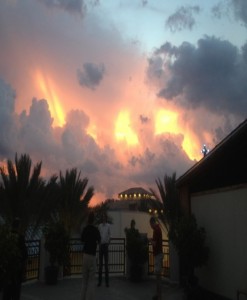The Analog Sunset – What Does It Mean for Your Digital Signage Extension Infrastructure (Part Two)
IT’S HERE. The analog sunset is a global change, and the term itself has become increasingly popular to describe the transition from the audio/video industry’s support of analog video, or analog and digital video signals, to only digital video signals.
 In the digital signage world, more and more players are no longer supporting analog outputs. They are all transitioning to supporting HDMI, DVI or DisplayPort outputs and as such, create huge challenges for any digital signage deployment involved with extension or distribution of signals. Most screen manufactures still support a VGA input; but that too is in peril over the next year or two.
In the digital signage world, more and more players are no longer supporting analog outputs. They are all transitioning to supporting HDMI, DVI or DisplayPort outputs and as such, create huge challenges for any digital signage deployment involved with extension or distribution of signals. Most screen manufactures still support a VGA input; but that too is in peril over the next year or two.
So what are the choices you have when you still need to extend your video from a player to a screen in your digital signage network? Continuing our discussion from yesterday…
Another choice you have in replacing your analog extension and distribution equipment involves moving away from the traditional out of band video distribution systems to an in-band, IP streaming solution. This involves replacing the DA with a digital encoder and replacing the receivers at your screens with decoders. The equipment replacement costs are usually higher (the encoders) but the system itself has some significant benefits. You can typically keep the cable from your analog distribution system and use it to connect your new networking devices. You can use off the shelf switches, routers and hubs and not need to rely on proprietary DA’s and receivers. You have additional flexibility in the sense that instead of a one to many restricted DA system, you now have your video in data format and it can go wherever you want it to. There are a number of different protocols available for streaming and we cover those in our Analog Sunset webinar.
The last choice I want to talk about today is replacing your existing analog extension and/or distribution system with players at screens. This choice, in the environments we are discussing is probably the most complex and most expensive way to go. You eliminate the challenge of distance. You add the cost of player licensing, the cost of repair for reaching players behind screens that may be difficult to reach during business hours or reaching during business hours disrupts the core business. You also need to deal with performance of players showing the same content in a venue, playing that content synchronized.
The fact remains that we will all need to transition our digital signage networks to support digital video over the next months and years. The technology that exists today provides for some alternatives. My question, for this blog is what’s next? Who has the next best thing to help digital signage network owners and operators keep their infrastructure maintenance costs under control while delivery top notch video to where it needs to be? Anyone?




No comments yet.